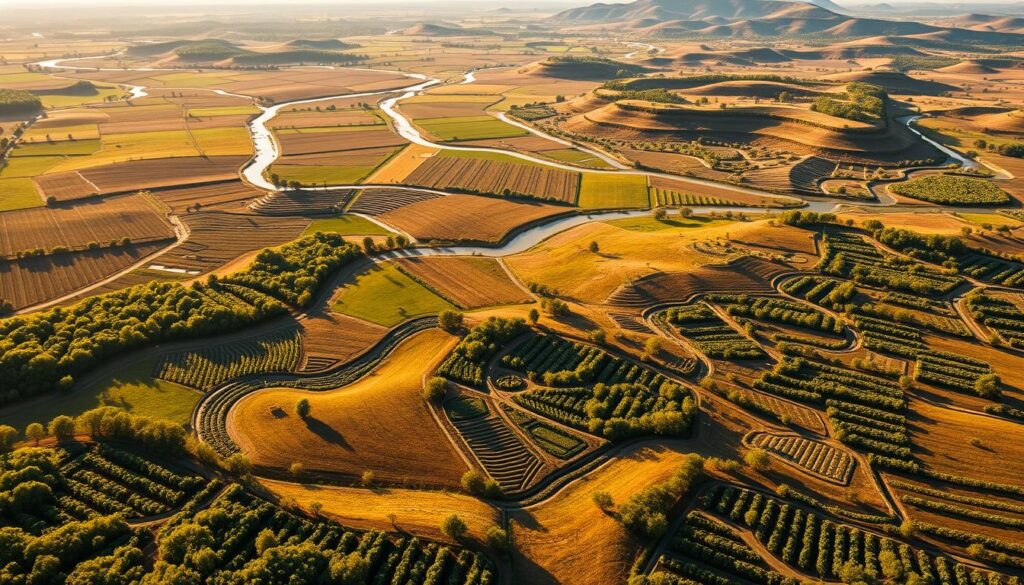Fractal patterns show complex shapes that repeat at different sizes. They are important in agriculture and land management. They help us understand how to improve soil health and crop production.
Using fractal geometry, farmers can adopt sustainable ways to increase productivity. This also makes the land more resilient. We explore how fractal patterns are used in soil science in this article.
The Significance of Fractal Patterns in Agriculture
Fractal patterns shed light on farming, especially in evaluating soil health and crop production. By studying fractal geometry, we see soil structures in new ways. Traditional methods often miss the complex ways soil properties interact. So, fractal analysis is a crucial tool for farmers and researchers.
Understanding Fractal Geometry
Fractal geometry is all about natural shapes that repeat themselves. It shows us how soil texture and makeup affect soil health. The idea of “fractal dimension” tells us how fractals fill space. This concept helps us grasp the variety and complexity in soils. By using fractal ideas, scientists learn more about soil features important for farming.
Applications in Soil Health and Crop Yield
Studies show that fractal analysis predicts key soil properties that help crops and nutrient cycles. By viewing soil particles through fractals, experts can spot important patterns. This knowledge leads to better ways to take care of soil, boosting crops and promoting green farming.

Fractal Patterns in Agriculture and Land Management
Study after study shows how important fractal patterns are in farming. These complex patterns found in nature tell us a lot about soil and how to manage land better. For farmers and people who take care of the land, this knowledge helps them make the right choices.
Key Research Insights
Recent research has found that fractal geometry helps us know more about soil and how it acts. Scientists have linked fractal dimensions with key soil features. These features are affected by things like invasive species and the amount of nutrients in the soil. This deeper knowledge helps improve farming methods, leading to better crop yields and less harm to the environment.
Case Studies in Modern Farming
There are many examples of how fractal analysis is used in today’s farming. Precision agriculture is one such example. By using fractal metrics, farmers know exactly which parts of their fields need more help.
This means they can farm more effectively and harm the environment less. This approach improves farm productivity and reduces the bad effects of old farming ways.
The Role of Fractal Analysis in Soil Science
Fractal analysis is a key tool for studying soil’s complex traits. It improves soil study by measuring small particle sizes. These sizes are often missed by usual methods.
Researchers find out how soil structure and porosity link to nutrient cycling. This knowledge is vital.
Quantifying Soil Particle Size Distribution
Fractal geometry helps scientists measure soil particles in detail. This method shows soil texture better, uncovering key points about fertility and how water stays in soil.
Using fractal metrics leads to better soil health signs. These improvements help farmers increase their crop yields.
Linking Fractal Metrics to Soil Health
Studies show soil fractals relate to soil health signs. For example, they make it easier to understand soil nutrients and breaking down processes.
This link underlines the need for soil saving plans. These plans come from good fractal analysis, pushing for lasting farming methods.
Fractal Dimension as an Indicator of Soil Properties
The fractal dimension is key in understanding soil. It offers insight into how soil properties connect with moisture and nutrients. By studying soil’s fractal dimension, experts can learn how it holds moisture and impacts nutrient levels.
Measuring Soil Moisture Dynamics
Scientists use fractal dimensions to check how soil holds water. Changes in the fractal dimension show the soil’s ability to keep moisture, especially with little rain. This is crucial for dealing with droughts, as it helps understand moisture distribution.
Keeping an eye on these patterns helps manage resources well in farming.
Correlations with Nutrient Composition
Fractal dimensions also tell us about soil’s nutrient content. Higher fractal dimensions mean better nutrients, key for plant growth and harvests. This link highlights how fractal analysis predicts nutrient availability.
Using fractal dimensions offers new ways to improve soil health and farm yields.
Innovative Techniques in Fractal Soil Analysis
Ground Penetrating Radar (GPR) has really changed how we look at soil. It lets us map out the soil in agricultural fields in detailed ways. This method doesn’t harm the soil and gives us lots of info. We can learn about soil moisture, how dense it is, and its resistance.
With these details, people who work with land can manage it better. Understanding the differences in soil helps a lot for this.
Ground Penetrating Radar (GPR) Applications
GPR is crucial for studying the soil deeper. It gives us clear pictures of what’s beneath the surface, letting us see soil health clearly. Some major perks of using GPR are:
- Seeing how soil layers are arranged.
- Finding out how moist different areas are.
- Spotting signs that soil is too packed or eroding.
When we match GPR data with fractal patterns, we get key insights. These help improve how we farm and can lead to better crops.
Combining Fractal Analysis with Geostatistics
Mixing fractal analysis with geostatistics gives us a strong tool. This mix makes it easier to predict how soil will act in various situations. Researchers have found many pluses to this approach:
- It’s easier to figure out soil types and where they are.
- This method helps with planning how to use resources wisely.
- It points out which areas need more attention or checks.
This way, people working in agriculture get a fuller picture of their land. This leads to farming that’s both more effective and better for the future.
The Impact of Land-Use Practices on Fractal Patterns
Land-use practices shape the fractal patterns found in soil. They affect soil health and the sustainability of farms. It’s key to compare conventional and conservation tillage for better land management.
Effects of Conventional vs. Conservation Tillage
Conventional tillage uses heavy machines that harm the soil. This can cause more erosion and damage to the land. On the other hand, conservation tillage keeps the soil covered and less disturbed. Studies show it leads to healthier soils with better fractal dimensions. This means it helps keep water and nutrients in the soil and reduces erosion risks.
Soil Erosion and Degradation Implications
Soil erosion is a big concern with conventional tillage. It often removes the topsoil necessary for growing crops. Conservation tillage, however, helps prevent erosion and keeps the soil healthy. By focusing on maintaining fractal patterns, farmers can fight land degradation. This boosts farming success and helps the environment, too.
Improving Agricultural Sustainability Through Fractal Analysis
Fractal analysis offers a new way to boost farming sustainability. It makes resource use more efficient and aids in adopting lasting farming ways. By using fractal measures in decisions, people can grasp soil changes and improve farm outputs.
Enhanced Resource Management Practices
Using fractal patterns can make farm resources go further. Key methods are:
- Precision farming techniques that allow for targeted application of fertilizers and water based on fractal insights.
- Data-driven decision making that leverages fractal metrics to enhance crop health and yield.
- Identifying soil variability to apply resources more efficiently, minimizing waste.
Future Trends in Sustainable Agriculture
New trends in green farming will come from studying fractal analysis. Some future changes might include:
- Adoption of advanced technologies in soil monitoring and analysis.
- Integration of artificial intelligence with fractal metrics to predict crop performance and manage resources effectively.
- Collaborative efforts among farmers, scientists, and policymakers to refine sustainable practices based on fractal findings.
Challenges and Limitations of Fractal Approaches
Fractal approaches in farming have many benefits but also face big challenges. Knowing these obstacles helps us improve soil study methods using fractals. We will look into data collection and analysis issues, and the problems of understanding fractal metrics in different soil types.
Data Collection and Analysis Issues
Gathering data for fractal analysis is tough. Getting correct soil property measurements is hard due to uneven sample sizes and the need for high-tech tools. Often, technology limits make it hard for researchers to get reliable data from various farm areas. This can make fractal metrics less useful in farming because their reliability drops.
Interpreting Fractal Metrics in Variable Conditions
Understanding fractal metrics adds more challenges. Since soil conditions vary a lot, using one way to interpret them can give wrong results. It’s important to know how these metrics work in different soil types for farming success. The uncertainty from soil variety makes it tough to create strong farming methods that work everywhere.
Conclusion
Exploring fractal patterns in agriculture shows the complex links in soil systems. By using fractal analysis, those in agriculture can make better decisions. This leads to more sustainable farming and higher crop yields.
Embracing these patterns helps with effective land management. It also promotes an ecological balance important for future generations. As farming faces challenges like climate change and more people, fractal patterns offer new solutions.
The use of fractal analysis in farming highlights its value in checking soil health and managing resources better. This method improves farming’s efficiency. It also matches the push for future farming innovations.
There’s a big chance for more research into fractal patterns. Such research could lead to sharper farming practices and land management strategies. Understanding soil better through fractal geometry helps us adapt. This is crucial for farming’s future in the United States.



